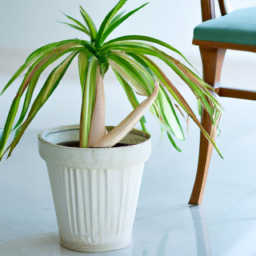
Have you ever thought about how indoor plants can help reduce your carbon footprint? In today’s world, sustainability is a hot topic, and finding ways to lessen our impact on the environment is more important than ever. One simple yet effective way to contribute to sustainability is by incorporating indoor plants into your living or working space. Indoor plants not only add beauty and life to your surroundings but also play a significant role in reducing carbon emissions. Let’s explore how indoor plants can make a positive impact on the environment and help you live a more eco-friendly lifestyle.
Benefits of Indoor Plants in Reducing Carbon Footprint
Indoor plants are not only aesthetically pleasing but also play a crucial role in reducing our carbon footprint and contributing to sustainability. By understanding how indoor plants help in improving air quality and reducing energy consumption, we can make informed choices to incorporate more greenery into our indoor spaces.
Improving Indoor Air Quality
One of the key benefits of indoor plants is their ability to improve air quality by filtering out harmful pollutants and toxins. Plants absorb carbon dioxide during photosynthesis and release oxygen, which helps to freshen up the air in our indoor spaces. Additionally, plants can remove volatile organic compounds (VOCs) such as formaldehyde and benzene, which are commonly found in indoor environments due to furniture, cleaning products, and building materials.
Moreover, indoor plants can also increase humidity levels, which can help to alleviate respiratory issues and reduce the transmission of airborne viruses. By having a variety of plants in different rooms of your home or office, you can create a healthier indoor environment for yourself and your loved ones.
Furthermore, indoor plants have been shown to have a positive impact on mental health and well-being. Studies have found that being around plants can reduce stress, anxiety, and depression, leading to improved productivity and overall happiness. By incorporating plants into your indoor spaces, you can create a more calming and peaceful environment for yourself.
Reducing Energy Consumption
In addition to improving air quality, indoor plants can also help to reduce energy consumption in buildings. Plants provide natural insulation, helping to regulate temperature and humidity levels, which can lead to lower heating and cooling costs. By strategically placing plants near windows or doors, you can block out direct sunlight in the summer and reduce heat loss in the winter.
Furthermore, plants can help to reduce the need for artificial lighting by reflecting and diffusing natural light throughout a room. This not only saves energy but also creates a more pleasant and comfortable lighting environment. By incorporating plants into your interior design, you can lower your carbon footprint and contribute to a more sustainable way of living.
Overall, indoor plants offer a wide range of benefits beyond just adding beauty to our indoor spaces. By improving air quality, reducing energy consumption, and enhancing our well-being, indoor plants play a vital role in reducing our carbon footprint and promoting sustainability. So, next time you’re looking to spruce up your home or office, consider adding some greenery to not only enhance the aesthetics but also contribute to a healthier and more eco-friendly environment.

The Role of Indoor Plants in Sustainable Living
Indoor plants play a crucial role in reducing our carbon footprint and promoting sustainability in our homes and workplaces. By understanding how indoor plants contribute to a healthier environment, we can make informed decisions about incorporating them into our daily lives.
Improving Indoor Air Quality
One of the key ways indoor plants contribute to sustainability is by improving indoor air quality. Plants absorb carbon dioxide and release oxygen through the process of photosynthesis, which helps to purify the air we breathe. In addition, plants can remove harmful toxins such as formaldehyde, benzene, and trichloroethylene from the air, making our indoor spaces healthier and more pleasant to be in.
Studies have shown that having indoor plants in our homes and offices can help reduce symptoms of sick building syndrome, such as headaches, fatigue, and respiratory issues. By filtering out pollutants and increasing oxygen levels, plants create a more comfortable and productive indoor environment for occupants.
Furthermore, plants can help regulate humidity levels in indoor spaces, which can reduce the need for energy-intensive air conditioning systems. By naturally humidifying the air, plants can help maintain a comfortable and healthy indoor climate, leading to energy savings and reduced carbon emissions.
Enhancing Mental Wellbeing
In addition to improving air quality, indoor plants have been shown to have a positive impact on mental wellbeing. Studies have found that being around plants can reduce stress, anxiety, and depression, while promoting feelings of relaxation and happiness. By bringing nature indoors, plants can create a sense of calm and connection to the natural world, which is essential for our overall health and wellbeing.
Having indoor plants in our living and working spaces can also boost creativity, productivity, and focus. Research has shown that being in a green environment can enhance cognitive function and problem-solving skills, leading to better performance and satisfaction in our daily activities. By incorporating plants into our indoor environments, we can create a more inspiring and productive atmosphere for ourselves and those around us.
Furthermore, caring for indoor plants can provide a sense of purpose and fulfillment, as we nurture and watch them grow. This connection to nature can help us feel more connected to the world around us and inspire us to make more sustainable choices in our daily lives.
Promoting Biodiversity and Ecosystem Health
Indoor plants play a vital role in promoting biodiversity and ecosystem health, even in urban environments. By providing habitat and food sources for insects, birds, and other wildlife, plants contribute to the overall health of our ecosystems and support a diverse range of species. In addition, indoor plants can help reduce urban heat island effects by providing shade, cooling the air, and reducing energy consumption.
By incorporating a variety of plant species into our indoor spaces, we can create mini ecosystems that support a rich diversity of life. This not only enhances the beauty and vibrancy of our indoor environments but also contributes to the conservation of biodiversity on a larger scale. By valuing and caring for indoor plants, we can play a part in protecting and preserving the natural world for future generations.
In conclusion, indoor plants play a multifaceted role in promoting sustainability and reducing our carbon footprint. By improving indoor air quality, enhancing mental wellbeing, and promoting biodiversity and ecosystem health, plants contribute to a healthier and more sustainable indoor environment. By incorporating plants into our daily lives, we can make a positive impact on our health, wellbeing, and the planet as a whole.

Maximizing Indoor Plant Benefits for Carbon Footprint Reduction
Indoor plants are not only aesthetically pleasing but also play a crucial role in reducing our carbon footprint. By understanding how indoor plants contribute to sustainability, we can maximize their benefits and create a greener environment for future generations.
The Role of Indoor Plants in Carbon Footprint Reduction
Indoor plants help reduce carbon dioxide levels in the air through the process of photosynthesis. During photosynthesis, plants absorb carbon dioxide and release oxygen, helping to purify the air we breathe. This natural process not only improves air quality but also helps to combat climate change by reducing the amount of carbon dioxide in the atmosphere.
In addition to absorbing carbon dioxide, indoor plants also help to regulate humidity levels in indoor spaces. By releasing water vapor through a process known as transpiration, plants can increase humidity levels, creating a more comfortable and healthier environment. This can help reduce the need for energy-intensive humidifiers and air conditioners, further reducing our carbon footprint.
Furthermore, indoor plants can act as natural air purifiers, removing harmful toxins and pollutants from the air. This can help improve indoor air quality and reduce the health risks associated with indoor air pollution. By incorporating a variety of indoor plants into our living and working spaces, we can create a healthier environment while also reducing our carbon footprint.
Maximizing the Benefits of Indoor Plants for Carbon Footprint Reduction
To maximize the benefits of indoor plants for carbon footprint reduction, it is important to choose the right plants for your space. Consider factors such as light levels, humidity levels, and maintenance requirements when selecting indoor plants. Choose plants that are known for their air-purifying qualities, such as spider plants, peace lilies, and pothos, to maximize their carbon-reducing benefits.
Proper care and maintenance of indoor plants are essential to ensure they can effectively reduce carbon dioxide levels and improve air quality. Be sure to water and fertilize your plants regularly, prune them as needed, and monitor for any signs of pests or disease. By providing the necessary care, you can help your indoor plants thrive and continue to contribute to carbon footprint reduction.
Incorporating a variety of indoor plants into your living and working spaces can help maximize their carbon-reducing benefits. Create a green oasis by placing plants throughout your home or office, including on windowsills, shelves, and desks. By surrounding yourself with nature, you can enjoy the many benefits of indoor plants while also reducing your carbon footprint.
In a Nutshell
Indoor plants are not just pretty decorations for your home or office – they also play a crucial role in reducing your carbon footprint and contributing to sustainability. These green companions help to purify the air by absorbing carbon dioxide and releasing oxygen through the process of photosynthesis. By doing so, they can help improve air quality and create a healthier indoor environment for you and your loved ones.
In addition to their air-purifying benefits, indoor plants also have a positive impact on energy consumption. By placing plants strategically near windows, they can provide shade and help regulate indoor temperatures, reducing the need for air conditioning in the summer and heating in the winter. This not only saves energy but also lowers your carbon emissions, making indoor plants a simple and effective way to contribute to a more sustainable lifestyle. So next time you’re looking to spruce up your living or workspace, consider adding some leafy friends to not only enhance the aesthetic but also make a positive impact on the planet.
Here are some FAQs you’d be interested in:
Q1. How do indoor plants contribute to reducing carbon footprint?
A1. Indoor plants help reduce carbon footprint by absorbing carbon dioxide during photosynthesis and releasing oxygen into the air. This process helps offset the carbon emissions produced by daily activities.
Q2. Do indoor plants improve air quality in addition to reducing carbon footprint?
A2. Yes, indoor plants not only help reduce carbon footprint but also improve air quality by filtering out harmful toxins and pollutants from the air. They act as natural air purifiers, creating a healthier indoor environment.
Q3. How many indoor plants are needed to make a significant impact on carbon footprint reduction?
A3. The number of indoor plants needed to make a significant impact on carbon footprint reduction depends on factors such as the size of the space, the types of plants, and the level of care provided. However, even a few well-maintained indoor plants can contribute to sustainability efforts.
Q4. What are some low-maintenance indoor plants that are effective in reducing carbon footprint?
A4. Some low-maintenance indoor plants that are effective in reducing carbon footprint include snake plants, pothos, spider plants, and peace lilies. These plants require minimal care and can thrive in various indoor environments.
Q5. Are there any other benefits of having indoor plants besides carbon footprint reduction?
A5. Yes, besides reducing carbon footprint, indoor plants offer numerous benefits such as stress reduction, improved mood, increased productivity, and enhanced overall well-being. They also add a touch of nature to indoor spaces, creating a more inviting and aesthetically pleasing environment.

Alex Turner is a sustainable gardening advocate and the founder of an acclaimed indoor gardening blog. With a focus on eco-friendly practices and urban sustainability, Alex combines his background in environmental studies with his love for plants to educate readers on mindful indoor gardening. His work highlights the importance of nurturing both plants and the planet.


